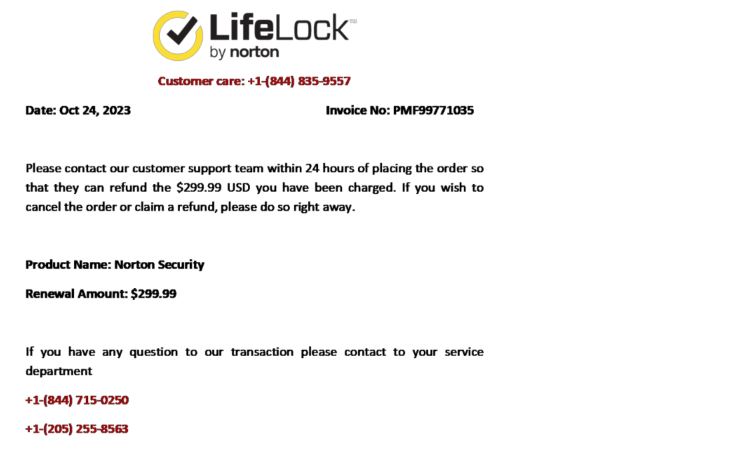Scam emails posing as Norton antivirus renewal notices are a frequent tactic used with the aid of cybercriminals to trick customers into sharing touchy non-public data or making fraudulent payments. These emails regularly mimic Norton's branding, the usage of logos, colors, and pressing language to create panic. This information offers actionable steps and insights, backed via dependable sources, to assist you discover and keep away from Norton scam emails, defending your non-public and financial information.
Understanding Norton Scam Emails
Norton rip-off emails normally declare that your antivirus subscription has expired or is about to expire, urging on-the-spot renewal. They may additionally encompass faux invoices, malicious links, or requests for touchy, important points like credit card information. These emails leverage confidence in the Norton company to deceive victims.

Common Characteristics of Norton Scam Emails
Urgent or threatening language: Phrases like "Your subscription has expired!" or "Your system is at instantaneous risk!" create panic.
Suspicious sender email addresses: Look for misspellings or uncommon domains (e.g., "support@norton-security.co" as an alternative to "norton.com").
Fake invoices or charge demands: Requests for instant charges through unofficial techniques like present playing cards or cryptocurrency.
Poor grammar or formatting: Legitimate Norton emails adhere to expert standards, not like scams with typos or inconsistent branding.
Unfamiliar hyperlinks or attachments: Links to phishing websites or attachments containing malware.

Avoid Clicking Links or Downloading Attachments
Never click on hyperlinks or download attachments in unsolicited emails. Instead, log in to your Norton account without delay with the aid of the respectable Norton website to test your subscription status.
Check Your Subscription Status Directly
If you obtain a renewal notice, affirm it by logging into your Norton account on the legitimate website or through the Norton 360 app. Your account dashboard suggests clear subscription details, which include renewal dates.
Be Wary of Urgent Language
Scammers use worry to rush you into action. Legitimate Norton emails are expert and avoid aggressive deadlines. Learn more about phishing procedures on Norton’s protection blog.
Look for Spelling or Grammar Errors
Official Norton communications are polished and error-free. Typos, awkward phrasing, or inconsistent branding are pink flags.
Avoid Sharing Personal Information
Norton in no way requests sensitive records like passwords, credit card details, or Social Security numbers by means of email. If an email asks for this, it’s a scam. Review Norton’s privacy coverage for the small print on information handling.
Use Two-Factor Authentication (2FA)
Enable 2FA on your Norton account to add a greater layer of security, stopping unauthorized get right of entry even if scammers acquire your password. Learn how to set it up on Norton’s guide page.
Report Suspicious Emails
Forward suspicious Norton emails to spam@nortonlifelock.com. Report phishing to the Federal Trade Commission (FTC) or your electronic mail provider’s unsolicited mail reporting tool. For international reporting options, go to Consumer Affairs.
Keep Your Antivirus Software Updated
Ensure your Norton antivirus software program is up to date to shield against malware from phishing mail attachments or links.
Educate Yourself and Others
Stay knowledgeable about phishing approaches and share your understanding with others. Resources like Norton’s Learning Center and the FTC’s purchaser safety web page provide precious tips.
What to Do If You’ve Been Scammed
Contact Norton Support: If you’ve shared non-public or fee information, contact Norton’s aid crew straight away by way of their guide web page or the established patron provider number on norton.com.
Monitor Your Accounts: Check financial institution and credit card statements for unauthorized transactions. Report suspicious exercise to your financial institution or go to IdentityTheft.gov for healing steps.
Change Passwords: Update passwords for your Norton account and any bills with comparable credentials. Use Norton’s password supervisor for impenetrable password management.
Run a Security Scan: Use a dependable antivirus software program like Norton 360 to scan your device for malware from phishing hyperlinks or attachments.
Report the Scam: File a complaint with the FTC or your country’s patron safety agency, such as Consumer Affairs.
How to Verify Legitimate Norton Communications
Official Website: Always use norton.com to take a look at the account's small print or contact support.
Customer Support: Reach out to Norton’s established aid channels listed on their help page.
Secure Payment Methods: Norton makes use of dependable payment methods for renewals and does not accept credit cards or wire transfers. Verify fee procedures on Norton’s billing page.
Conclusion
Norton rip-off emails and pretend renewal notices are the most likely to instill confidence and urgency to deceive users. By staying vigilant, verifying sender details, and using legitimate channels like norton.com to manage your account, you can keep away from these scams. Protect your facts by following the steps above and reporting suspicious emails to spam@nortonlifelock.com.
For greater records on staying protected online, rely on sources like Norton’s Learning Center or the FTC’s buyer safety page.
Source: This content material is stimulated by and tailored from records accessible at AntivirusNinja - How to Avoid Norton Scam Email.









